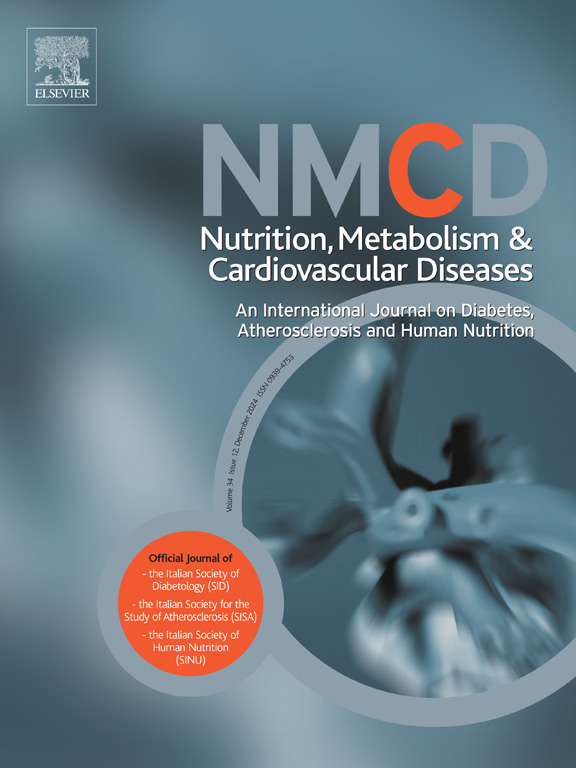Phase angle is associated with inflammatory parameters in young adults and adults with metabolic syndrome in a population-based study
IF 3.3
3区 医学
Q2 CARDIAC & CARDIOVASCULAR SYSTEMS
Nutrition Metabolism and Cardiovascular Diseases
Pub Date : 2025-03-29
DOI:10.1016/j.numecd.2025.104028
引用次数: 0
Abstract
Background and aims
Phase angle (PhA) is suggested to reflect cell health. PhA association with inflammation and adiposity in metabolic syndrome (MetS) presence or absence, remains unclear. In the general population, PhA association with C-reactive protein (CRP) is controversial, and studies on PhA with other inflammatory markers are a literature gap. This study aims to evaluate the association of PhA with inflammatory and adiposity-related parameters in males and females with and without MetS.
Methods and results
Cross-sectional study with 597 adults (38.4 years; CI95 % 36.35–40.45) categorized into MetS (n = 126, 57.9 % female) and non-MetS (n = 471, 55.2 % female). Single-frequency bioimpedance analysis evaluated PhA. Adiposity-related (BMI, visceral adiposity index, and body fat percentage (%BF) by dual-energy x-ray emission) and serum inflammatory parameters (CRP, TNF-α, IL-6, IL-10, IL-1β, IL-8, IL-12p70) were evaluated. Regression analyses adjusted by age, and physical activity level, with or without %BF, evaluated the associations. In males MetS, PhA was negatively associated with %BF, IL-6, IL-10, IL-1β, and IL-12p70 (β = −0.07, p = 0.005, β = −0.03, p = 0.035, β = −0.06, p = 0.006, β = −0.03, p = 0.048, β = −0.02, p = 0.038, respectively) and positively associated with BMI (β = 0.07, p = 0.003) in non-MetS. In females MetS, PhA was negatively associated with TNF-α and IL-12p70 (β = −0.02, p = 0.048, β = −0.01, p = 0.016, respectively) and positively with IMC, %BF, TNF-α and IL-8 (β = 0.07, p < 0.001, β = 0.02, p = 0.021, β = 0.02, p = 0.011, β = 0.01, p = 0.035, respectively) in non-MetS.
Conclusion
In MetS individuals, higher PhA values are associated with lower inflammatory parameters in both sexes and %BF in males. The different behavior of PhA in females, suggests caution when interpreting PhA in this population.

在一项基于人群的研究中,相位角与年轻人和代谢综合征成年人的炎症参数相关。
背景与目的:建议用相位角(PhA)来反映细胞的健康状况。PhA与代谢综合征(MetS)存在或不存在的炎症和肥胖的关系尚不清楚。在一般人群中,PhA与c反应蛋白(CRP)的相关性存在争议,而PhA与其他炎症标志物的研究也是文献空白。这项研究的目的是评估PhA与炎症和肥胖相关参数在男性和女性有和没有MetS的关系。方法和结果:横断面研究597名成人(38.4岁;CI95 %(36.35 ~ 40.45)分为MetS (n = 126,女性占57.9%)和non-MetS (n = 471,女性占55.2%)。单频生物阻抗分析评价PhA。评估肥胖相关指标(BMI、内脏脂肪指数、双能x线放射体脂率%BF)和血清炎症参数(CRP、TNF-α、IL-6、IL-10、IL-1β、IL-8、IL-12p70)。根据年龄和体力活动水平调整的回归分析,有或没有%BF,评估相关性。在男性大都会,PhA是负相关的% BF, il - 6、il - 10、il - 1β,和IL-12p70(β= -0.07,p = 0.005,β= -0.03,p = 0.035,β= -0.06,p = 0.006,β= -0.03,p = 0.048,β= -0.02,p = 0.038)和与BMI呈正相关(β= 0.07,p = 0.003) non-MetS。在女性met中,PhA与TNF-α和IL-12p70呈负相关(β = -0.02, p = 0.048, β = -0.01, p = 0.016),与IMC、%BF、TNF-α和IL-8呈正相关(β = 0.07, p)。结论:在met个体中,较高的PhA值与两性较低的炎症参数和男性较低的BF有关。PhA在女性中的不同表现,提示在解释这一人群中的PhA时要谨慎。
本文章由计算机程序翻译,如有差异,请以英文原文为准。
求助全文
约1分钟内获得全文
求助全文
来源期刊
CiteScore
6.80
自引率
2.60%
发文量
332
审稿时长
57 days
期刊介绍:
Nutrition, Metabolism & Cardiovascular Diseases is a forum designed to focus on the powerful interplay between nutritional and metabolic alterations, and cardiovascular disorders. It aims to be a highly qualified tool to help refine strategies against the nutrition-related epidemics of metabolic and cardiovascular diseases. By presenting original clinical and experimental findings, it introduces readers and authors into a rapidly developing area of clinical and preventive medicine, including also vascular biology. Of particular concern are the origins, the mechanisms and the means to prevent and control diabetes, atherosclerosis, hypertension, and other nutrition-related diseases.

 求助内容:
求助内容: 应助结果提醒方式:
应助结果提醒方式:


